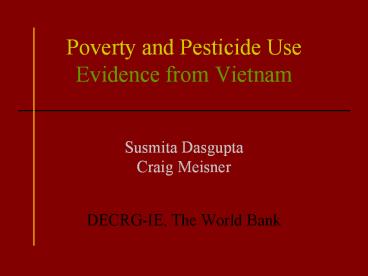Poverty and Pesticide Use Evidence from Vietnam PowerPoint PPT Presentation
1 / 18
Title: Poverty and Pesticide Use Evidence from Vietnam
1
Poverty and Pesticide Use Evidence from Vietnam
- Susmita Dasgupta
- Craig Meisner
- DECRG-IE, The World Bank
2
Pesticide consumption (metric tons)
Pesticide consumption has more than doubled in
the past decade
Source FAO, 2004
3
Alarming Composition / Application of Pesticides
- In 2000, a nation-wide survey by PPD found
- 2,500 kg of banned pesticides (Methamidophos, DDT
and others). - 4,753 liters and 5,645 kg of illegally imported/
counterfeit pesticides. - In 2000, another survey in the South found
- 96.6 of the farmers over-use pesticides.
- 95 of the farmers pour residual spray into
canals/ ditches/ re-apply it on other plants/
over-apply it to the same crop to get rid of it.
4
Limited Secondary Data on Health Effects
- Hospital admission records trace 840 poisonings
to pesticides in 53 cities and provinces in 1999.
- The WHO estimates that there are 50 cases of
poisoning for every case reported and registered.
5
Hypotheses of Interest
- Whether the use of hazardous pesticides is more
prevalent among poor farmers than in the general
farming population. - Whether overuse and misuse of pesticides is more
prevalent among poor farmers than in the general
farming population. - Whether poor farmers have less access to
information on risk, training for safe handling
of pesticides and protective measures than the
general farming population. - Whether health impairments, that may be
attributed to pesticide use, are
disproportionately higher for poor farmers.
6
Collaborators in Vietnam
- University of Economics
- Ho Chi Minh City
- (Contact Dr. Nguyen Huu Dung )
- The Centre of Occupational and Environmental
Health, Vietnam Association of Occupational
Health (Contact Dr. Khuc Xuyen )
7
World Bank PEN Study on Pesticide Use in Vietnam
2004
8
Sample Poverty Distribution
Poverty line based on per capita income VND
80,000 per month for island areas and rural
mountainous areas, VND 100,000 per month for
rural plain areas, and VND 150,000 per month in
urban areas (as per the definition stated in the
PRSP)
9
Pesticide Use Amount
Mean pesticide application, risk-weighted
amount and number of applications by
poor/non-poor (kg)
- Statistically significant at 1 level of
significance - Statistically significant at 5
level of significance
10
Pesticide Use Class
Mean application of WHO Ia b and common
pesticide classes by poor/non-poor (kg)
- Statistically significant at 1 level of
significance
11
Summary and Conclusions-I
- The poor are currently using smaller amounts of
pesticides (as well as on a per hectare basis).
In terms of risk-weighed pesticides, on average
the poor are using more, however this difference
is statistically insignificant. - By weighting a pesticides active ingredient by
its degree of lethality (or by the LD50 value)
and categorizing this measure according to the
WHO risk classification system, the poor are
using a greater percentage of WHO Ia Ib
pesticides on average, however this difference
was not statistically significant. - The non-poor are using a statistically greater
amount of organophosphates and pyrethroids.
12
Overuse of pesticides
- Poor farmers have a significantly lower
probability of overusing pesticides.1 - Other variables that contributed to the
determination of overuse were farm size (),
income () and the proportion of WHO class II ()
pesticides used in production. - Overuse was also found to be more prevalent in
the provinces of An Giang and Cantho.
1 - Overuse was defined as the reported dose
amount over the label then summed across all
pesticides used. It was then coded as 1 for
positive amounts, 0 otherwise.
13
Misuse of pesticidesDo farmers use any
pesticides recommended for other crops, on rice?
Non-poor farmers tended to misuse more often
significant at the 5 level of significance.
14
Prevalence of basic training on safe handling and
application of pesticides by poor/non-poor
Poor and non-poor farmers had no significant
difference in training amount.
15
Use of protective clothing while using pesticides
()
Non-poor farmers use more protective measures and
this is statistically significant at the 5 level.
16
Stated reasons for not wearing the protective
clothing by poor/non-poor ()
17
Prevalence of Environment-Friendly Pest Control
Measures by poor/non-poor
Non-poor farmers were more likely to adopt
alternative pest control methods significant at
the 1 level.
18
Summary and Conclusions-II
- Poor farmers have a significantly lower
probability of overusing pesticides. - Non-poor farmers are more likely to misuse.
- There is no difference in the level of training
among the poor and non-poor. - Non-poor farmers use more protective measures
while handling pesticides. - Non-poor adopted more environment-friendly pest
control methods.

